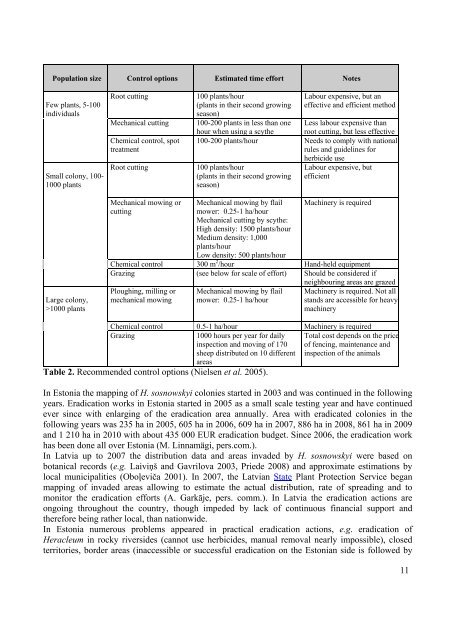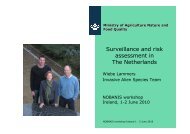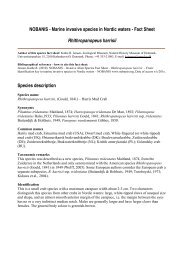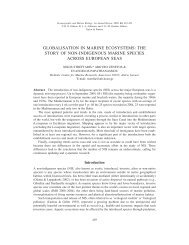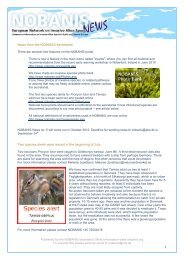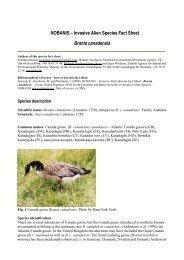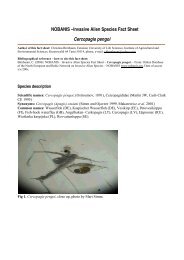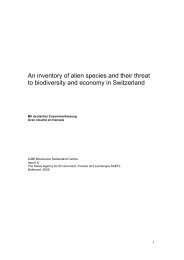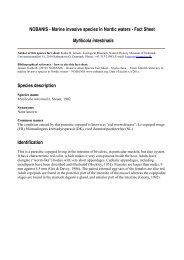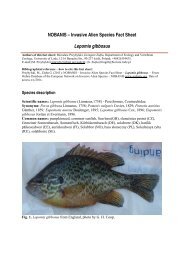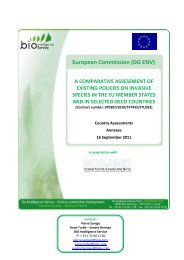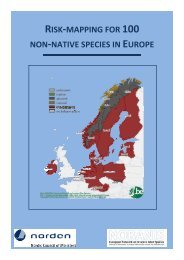NOBANIS – Invasive Alien Species Fact Sheet Heracleum sosnowskyi
NOBANIS – Invasive Alien Species Fact Sheet Heracleum sosnowskyi
NOBANIS – Invasive Alien Species Fact Sheet Heracleum sosnowskyi
Create successful ePaper yourself
Turn your PDF publications into a flip-book with our unique Google optimized e-Paper software.
Population size<br />
Few plants, 5-100<br />
individuals<br />
Small colony, 100-<br />
1000 plants<br />
Large colony,<br />
>1000 plants<br />
Control options<br />
Estimated time effort<br />
Root cutting 100 plants/hour<br />
(plants in their second growing<br />
season)<br />
Mechanical cutting 100-200 plants in less than one<br />
Notes<br />
Labour expensive, but an<br />
effective and efficient method<br />
hour when using a scythe<br />
Less labour expensive than<br />
root cutting, but less effective<br />
Chemical control, spot 100-200 plants/hour Needs to comply with national<br />
treatment<br />
rules and guidelines for<br />
herbicide use<br />
Root cutting 100 plants/hour<br />
Labour expensive, but<br />
(plants in their second growing<br />
season)<br />
efficient<br />
Mechanical mowing or<br />
cutting<br />
Mechanical mowing by flail<br />
mower: 0.25-1 ha/hour<br />
Mechanical cutting by scythe:<br />
High density: 1500 plants/hour<br />
Medium density: 1,000<br />
plants/hour<br />
Low density: 500 plants/hour<br />
Machinery is required<br />
Chemical control 300 m 2 /hour Hand-held equipment<br />
Grazing (see below for scale of effort) Should be considered if<br />
Ploughing, milling or<br />
mechanical mowing<br />
Mechanical mowing by flail<br />
mower: 0.25-1 ha/hour<br />
neighbouring areas are grazed<br />
Machinery is required. Not all<br />
stands are accessible for heavy<br />
machinery<br />
Chemical control 0.5-1 ha/hour Machinery is required<br />
Grazing<br />
1000 hours per year for daily Total cost depends on the price<br />
inspection and moving of 170 of fencing, maintenance and<br />
sheep distributed on 10 different<br />
areas<br />
inspection of the animals<br />
Table 2. Recommended control options (Nielsen et al. 2005).<br />
In Estonia the mapping of H. <strong>sosnowskyi</strong> colonies started in 2003 and was continued in the following<br />
years. Eradication works in Estonia started in 2005 as a small scale testing year and have continued<br />
ever since with enlarging of the eradication area annually. Area with eradicated colonies in the<br />
following years was 235 ha in 2005, 605 ha in 2006, 609 ha in 2007, 886 ha in 2008, 861 ha in 2009<br />
and 1 210 ha in 2010 with about 435 000 EUR eradication budget. Since 2006, the eradication work<br />
has been done all over Estonia (M. Linnamägi, pers.com.).<br />
In Latvia up to 2007 the distribution data and areas invaded by H. <strong>sosnowskyi</strong> were based on<br />
botanical records (e.g. Laiviņš and Gavrilova 2003, Priede 2008) and approximate estimations by<br />
local municipalities (Oboļeviča 2001). In 2007, the Latvian State Plant Protection Service began<br />
mapping of invaded areas allowing to estimate the actual distribution, rate of spreading and to<br />
monitor the eradication efforts (A. Garkāje, pers. comm.). In Latvia the eradication actions are<br />
ongoing throughout the country, though impeded by lack of continuous financial support and<br />
therefore being rather local, than nationwide.<br />
In Estonia numerous problems appeared in practical eradication actions, e.g. eradication of<br />
<strong>Heracleum</strong> in rocky riversides (cannot use herbicides, manual removal nearly impossible), closed<br />
territories, border areas (inaccessible or successful eradication on the Estonian side is followed by<br />
11


